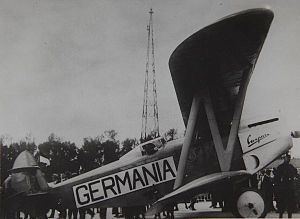Top speed 158 km/h Length 9.1 m | Wingspan 15 m | |
 | ||
The Caspar C 32 was an aircraft developed in Germany for aerial spraying in the late 1920s. It was a single-bay biplane with staggered, equal-span wings that accommodated the pilot and a single passenger or observer in tandem open cockpits. A small, additional horizontal stabiliser was fitted near the top of the tall single tail fin above the main horizontal stabiliser, making the tail an inverted sesquiplane.
The first example was used by the Biologische Reichsanstalt für Land- und Forstwirtschaft in Berlin until the early 1930s, before being acquired by DVS in 1933. DVS also purchased two examples directly from Caspar.
The fourth and last C 32 built was bought by the Graf Solms-Laubach and named Germania. Otto Könnecke was to have made a transatlantic crossing with it, but ongoing bad weather led to the continuous postponing of the event. Eventually, the plan was changed to making an eastward flight to the United States, via India and Japan. Könnecke departed Cologne on 27 September 1927, but by early 1928 was forced to turn back having only reached India.
Specifications
General characteristics
Performance
